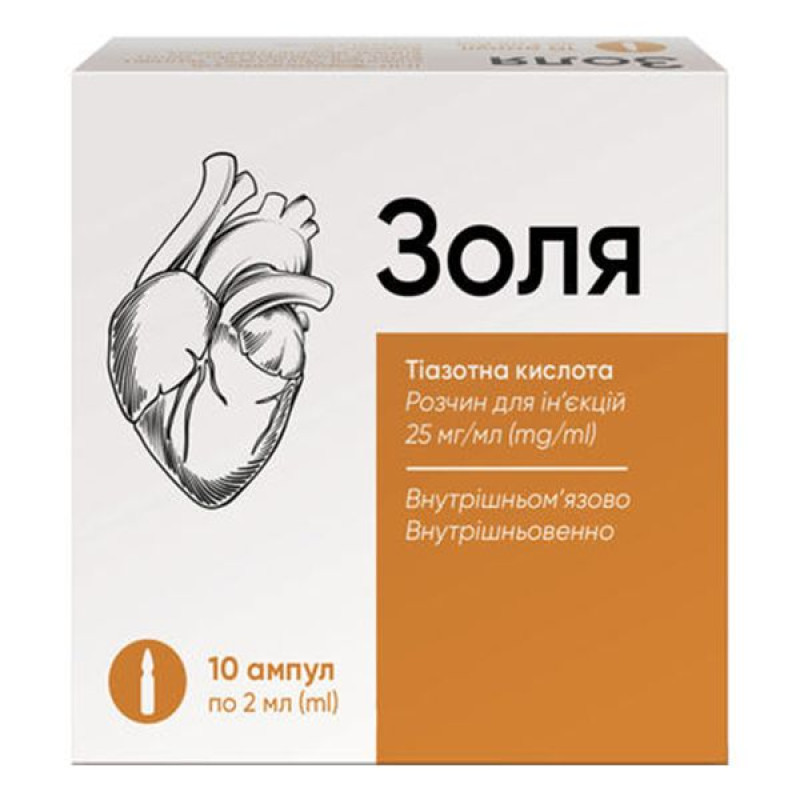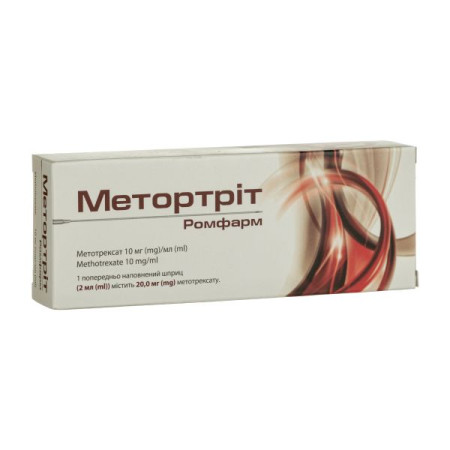Zola solution for injection 25 mg/ml ampoule 2 ml No. 10

Instructions Zola solution for injection 25 mg/ml ampoule 2 ml No. 10
Composition
active ingredient: thiazide acid;
1 ml of the drug contains morpholinium salt of thiazide acid – 25 mg, which is equivalent to 16.6 mg of thiazide acid;
excipient: water for injections.
Dosage form
Solution for injection.
Main physicochemical properties: clear, colorless or slightly yellowish liquid.
Pharmacotherapeutic group
Cardiological drugs. Other cardiological drugs. Thiazide acid.
ATX code C01E B23.
Pharmacological properties
Pharmacodynamics.
The pharmacological effect of thiazide acid is due to its anti-ischemic, membrane-stabilizing, antioxidant, and immunomodulatory effects.
The effect of the drug is realized by enhancing the compensatory activation of anaerobic glycolysis and activation of oxidation processes in the Krebs cycle with the preservation of the intracellular ATP pool. The presence in the structure of the thiazolidinedione molecule of sulfur thiol, which is characterized by redox properties, and tertiary nitrogen, which binds excess hydrogen ions, causes the activation of the antioxidant system. The strong reducing properties of the thiol group cause a reaction with reactive oxygen species and lipid radicals. Reactivation of antiradical enzymes - superoxide dismutase, catalase and glutathione peroxidase - prevents the initiation of reactive oxygen species.
The effect of thiazide acid leads to inhibition of lipid oxidation processes in ischemic areas of the myocardium, reduction of myocardial sensitivity to catecholamines, prevention of progressive inhibition of cardiac contractile function, stabilization and reduction of the necrosis and ischemia zones of the myocardium, respectively. Improvement of the rheological properties of the blood is achieved by activating the fibrinolytic system. Improvement of myocardial metabolic processes, increase of its contractility, promotion of normalization of heart rhythm allow us to recommend thiazide acid for the treatment of patients with various forms of ischemic heart disease.
In parallel with the use of the drug in cardiology, thiazide acid is used in the treatment of diseases of the liver and other internal organs, given the high hepatoprotective properties of the drug. The drug prevents the destruction of hepatocytes, reduces the degree of fatty infiltration and the spread of centrilobular necrosis of the liver, promotes the processes of reparative regeneration of hepatocytes, normalizes their protein, carbohydrate, lipid and pigment metabolism. Increases the rate of synthesis and secretion of bile, normalizes its chemical composition.
Pharmacokinetics.
The maximum concentration of thiazide acid in the blood plasma is achieved after intramuscular administration - after 0.84 hours, after intravenous administration - after 0.1 hours. Binding to blood proteins does not exceed 10%. Thiazide acid accumulates mainly in the kidneys - 31%. In significant quantities, it accumulates in the colon, heart, spleen, the smallest - in the small intestine and lungs (1-2%).
Indication
In the complex treatment of ischemic heart disease: angina pectoris, myocardial infarction, post-infarction cardiosclerosis; as an additional agent in the therapy of cardiac arrhythmias.
In the complex treatment of chronic hepatitis, alcoholic hepatitis, fibrosis and cirrhosis of the liver.
Contraindication
Hypersensitivity to thiazide acid, acute renal failure.
Interaction with other medicinal products and other types of interactions
The drug as a cardioprotective drug can be used in combination with basic treatment methods for ischemic heart disease. As a hepatoprotective agent, it can be combined with the appointment of traditional methods of treatment for hepatitis of the corresponding etiology.
Application features
Missing.
Use during pregnancy or breastfeeding.
Experience with the use of the drug during pregnancy or breastfeeding is insufficient.
The ability to influence the reaction speed when driving vehicles or other mechanisms.
In case of adverse reactions from the central and peripheral nervous system, caution should be exercised when driving vehicles and working with other complex mechanisms.
Method of administration and doses
In case of myocardial infarction and unstable angina, the drug is administered intravenously slowly at 4 ml of a 25 mg/ml solution (100 mg) at a rate of 2 ml/min or intravenously drip at a rate of 20–30 drops per minute (4 ml of a 25 mg/ml solution is diluted in 150‑250 ml of 0.9% sodium chloride solution) or administered intramuscularly at 4 ml of a 25 mg/ml solution (100 mg) 2–3 times a day. The course of treatment is 14 days.
For angina pectoris, the drug is administered intramuscularly in a dose of 4 ml of a 25 mg/ml solution 2 times a day (daily dose – 200 mg). The course of treatment is 14 days.
In chronic hepatitis with pronounced activity of the process, the drug should be administered intramuscularly in the first 5 days at 2 ml of a 25 mg/ml solution (50 mg each) 2–3 times a day or intravenously slowly at a rate of 2 ml/min at 4 ml of a 25 mg/ml solution (100 mg) once a day, or drip at a rate of 20–30 drops per minute (2 ampoules of a 25 mg/ml solution are diluted in 150–250 ml of 0.9% sodium chloride solution).
From the 5th to the 20th day of therapy, prescribe the drug in tablet form (100 mg 3 times a day).
In chronic hepatitis of minimal and moderate activity, the drug is administered intramuscularly in a dose of 2 ml of 25 mg/ml solution 3 times a day. The course of treatment is 20-30 days.
In case of liver cirrhosis, the course of treatment is 60 days. Treatment should be started with intramuscular injection of 2 ml of 25 mg/ml solution (50 mg) 3 times a day for 5 days, and then continue treatment with tablets (100 mg 3 times a day).
Children.
Experience with the use of the drug in children is insufficient.
Overdose
In case of overdose, the concentration of sodium and potassium in the urine increases. In such cases, the drug must be discontinued. Treatment is symptomatic.
Side effects
The drug is usually well tolerated. In patients with increased individual sensitivity, the following may occur:
Skin and subcutaneous tissue disorders: itching, skin hyperemia, rash, cases of urticaria.
On the part of the immune system: cases of angioedema and anaphylactic shock have been described when taking other drugs.
Others: fever, cases of chills and changes at the injection site.
In patients, mainly elderly, when taking other drugs, the following may occur:
From the side of the central and peripheral nervous system: general weakness, dizziness, tinnitus, headache.
From the cardiovascular system: tachycardia, arterial hypertension, cases of decreased blood pressure.
On the part of the digestive tract: manifestations of dyspeptic phenomena, including dry mouth, nausea, bloating, vomiting.
From the respiratory system: shortness of breath, wheezing.
Reporting of adverse reactions
Reporting adverse reactions after the registration of a medicinal product is important. This allows monitoring of the benefit/risk ratio when using this medicinal product. Medical and pharmaceutical professionals, as well as patients or their legal representatives, should report all cases of suspected adverse reactions and lack of efficacy of the medicinal product via the Automated Information System for Pharmacovigilance at the link: https://aisf.dec.gov.ua.
Expiration date
2 years.
Storage conditions
Store in the original packaging at a temperature not exceeding 25 °C.
Keep out of reach of children.
Packaging
2 ml in ampoules No. 10 (5×2) in blisters in a cardboard box; 4 ml in ampoules No. 10 (5×2) in blisters in a cardboard box.
Vacation category
According to the recipe.
Producer
Limited Liability Company "Pharmaceutical Company "Zdorovya".
Location of the manufacturer and address of its place of business.
Ukraine, 61013, Kharkiv region, Kharkiv city, Shevchenko street, building 22.
There are no reviews for this product.
There are no reviews for this product, be the first to leave your review.
No questions about this product, be the first and ask your question.





